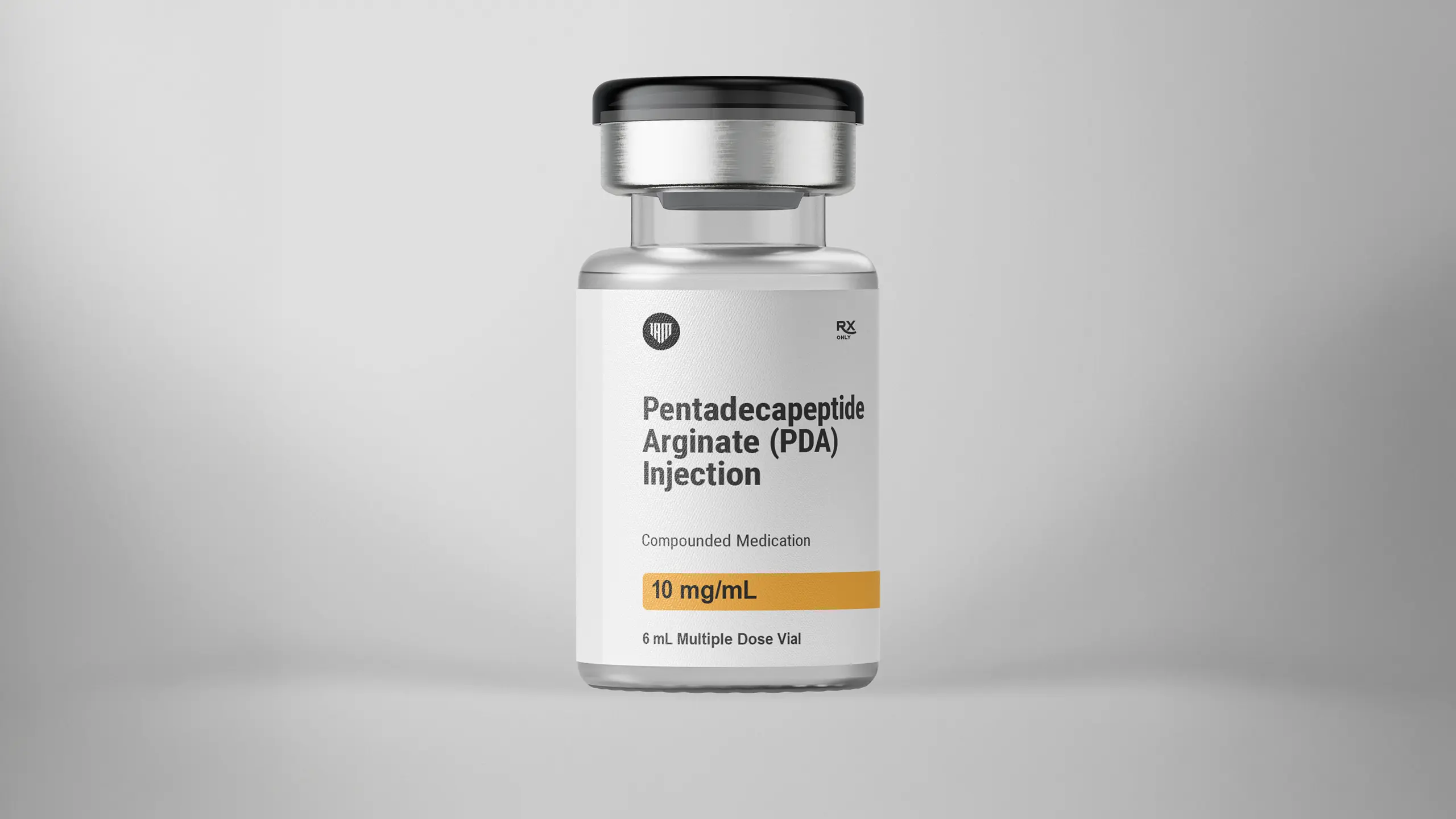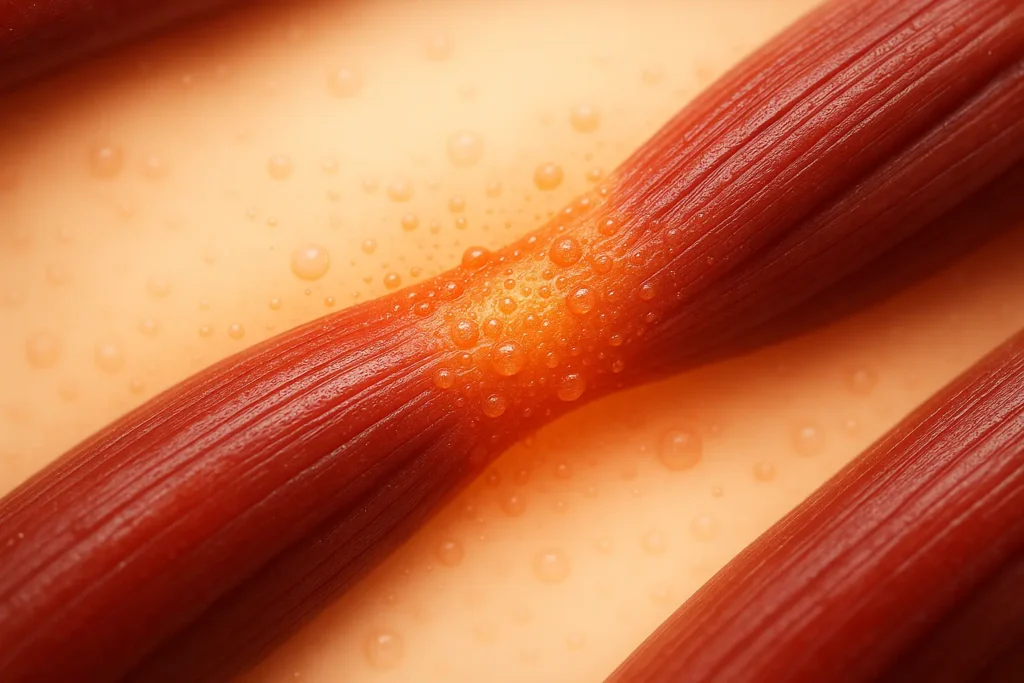The recovery peptide that’s getting more attention
PDA is showing up in conversations about healing and recovery. Here’s what it actually does and why some guys are choosing it over BPC-157.
Let’s talk about something you’ve probably heard mentioned
You know that guy who bounces back from injuries faster than everyone else? Who seems to recover from workouts like he’s 25, even though he’s not? Who had that nagging shoulder issue that just… disappeared?
There’s a chance he’s using Pentadecapeptide Arginate—or PDA for short. And before you think “that sounds way too scientific”—it’s actually becoming more common among those who are serious about recovery and healing.
Here’s what’s happening: injuries, chronic pain, and slow recovery aren’t just “part of getting older.” Your body has natural healing mechanisms that can be supported. Many folks are exploring ways to enhance their recovery instead of just hoping time will fix everything.
What PDA actually is
PDA is essentially the next-generation version of BPC-157, which you might have heard about in recovery and bodybuilding circles.
Think of it this way: BPC-157 was already known for helping with tissue repair and healing. PDA takes that same foundation but adds improvements that make it more stable and potentially more effective.
The key difference: PDA has an “arginate” addition that makes it much more stable, especially in acidic environments like your stomach. This means it doesn’t break down as quickly and can be more effective whether you inject it or take it orally.
What this means practically:
- Better tissue repair for muscles, tendons, and ligaments
- Reduced inflammation in injured areas
- Improved blood flow to help healing
- Enhanced recovery from workouts or injuries
- Support for chronic issues like tendonitis or joint problems
If BPC-157 is Wolverine healing, PDA is Deadpool-level regeneration
Why your body needs help with recovery
Let’s be honest about what modern life does to your recovery:
You’re probably pushing through pain. That shoulder that’s been bothering you for months. The knee that’s “not that bad.” The back that’s tight every morning. You’ve learned to work around these issues instead of actually addressing them.
Your workouts are beating you up. You lift, you run, you play sports, but you’re not 25 anymore. Recovery takes longer, and those minor aches are becoming permanent fixtures.
Stress is slowing healing. Work stress, sleep deprivation, poor nutrition—all of this interferes with your body’s natural ability to repair itself.
Previous injuries aren’t fully healed. That ankle sprain from five years ago, the pulled muscle that “got better”—they often leave behind scar tissue and dysfunction that affects everything else.
The practical reality of using PDA
How it’s administered: PDA can be given as a small injection under the skin or taken orally. The injection form is typically more potent, but the oral option exists for guys who prefer to avoid needles.
The injection factor: If needles make you nervous, that’s completely normal. The needles are tiny (like insulin needles), and most guys say it’s much easier than they expected. Many report that seeing their nagging injuries actually improve makes any initial hesitation worth it.
Timeline expectations:
- Minor improvements in pain or inflammation within 1-2 weeks
- Noticeable healing progress in 2-4 weeks
- Significant tissue repair and recovery in 4-6 weeks
- Chronic issues may take 6-12 weeks of consistent use
Treatment duration: Most patients use it for specific treatment periods—2-4 weeks for acute injuries, 4-8 weeks for chronic issues, or longer cycles for serious joint or cartilage problems.
What makes PDA different from BPC-157
If you’ve heard of BPC-157, you might wonder why someone would choose PDA instead:
Stability: PDA doesn’t break down as quickly, so it potentially works better and longer in your system.
Cardiovascular benefits: The arginate addition helps with nitric oxide production, which improves blood flow and circulation. Better blood flow means better healing.
Enhanced effectiveness: Many patients report that PDA seems to work faster and more consistently than BPC-157 for similar issues.
Who’s actually using this
PDA tends to appeal to those who:
- Have chronic injuries or pain that won’t go away
- Are serious athletes or lifters who need faster recovery
- Have tried physical therapy, rest, and other approaches without full resolution
- Want to be proactive about healing instead of just managing symptoms
- Are already comfortable with peptide therapy
It’s particularly popular for:
- Tendon and ligament injuries
- Chronic joint pain or arthritis
- Muscle strains that won’t fully heal
- Post-surgery recovery
- Gut health issues (though this is more experimental)
The honest assessment
Let’s be real about what PDA can and can’t do:
What guys typically report:
- Reduced pain and inflammation in problem areas
- Faster recovery from workouts
- Improvement in chronic issues that haven’t responded to other treatments
- Better sleep when pain was interfering
- Increased ability to train without aggravating injuries
What to keep in perspective:
- It’s not going to fix everything overnight
- Serious injuries may still need other interventions
- It works best when combined with proper rest, nutrition, and sometimes physical therapy
- Individual responses vary. Some folks see dramatic improvements, others see modest benefits
The research reality: PDA builds on the research foundation of BPC-157, but specific studies on PDA are still developing. Much of what we know comes from clinical use and user reports.
Whether it makes sense for you
PDA might be worth considering if:
- You have nagging injuries or chronic pain that isn’t fully resolving
- You’ve tried conventional treatments without complete success
- You’re serious about optimizing recovery and performance
- You’re comfortable with peptide therapy
- You want to be proactive about healing rather than just managing symptoms
It’s probably not right if:
- You’re looking for a quick fix without addressing underlying issues
- You have acute injuries that need immediate medical attention
- You’re not willing to commit to a proper treatment protocol
- You expect instant, dramatic results
The bigger picture
PDA represents a shift in how some guys think about injuries and recovery. Instead of just accepting that “this is how it is now” or only treating symptoms, it’s about actively supporting your body’s natural healing processes.
This isn’t about becoming obsessive about every minor ache. It’s about recognizing that your body’s ability to heal and recover can be optimized, just like your fitness or your hormones.
Your nagging injuries and slow recovery are going to continue whether you do something about them or not. The question is whether you want to support your body’s healing processes or just hope things improve on their own.
For men and women who are already optimizing other aspects of their health and performance, such as testosterone optimization, PDA is becoming another tool in the toolkit, alongside proper training, nutrition, sleep, and other targeted therapies.
The bottom line
PDA isn’t going to turn you into a superhuman healing machine, but it might help your body do what it’s trying to do anyway, repair faster and recover properly.
If you’ve been dealing with chronic pain, slow recovery, or injuries that just won’t fully heal, it’s worth understanding your options. Many guys and gals spend years working around problems that could potentially be addressed more directly.
The choice is simple: keep managing symptoms and hoping time will fix things, or explore what’s possible when you actively support your body’s natural healing processes.
Most people wait until an injury becomes a major problem before exploring advanced recovery options. But those who seem to never stay injured for long? They’re usually thinking about recovery before there’s a crisis.
Ready to learn if PDA might help with your recovery goals? Our providers specialize in peptide therapy and can help you understand whether tissue repair peptides make sense for your specific situation.

